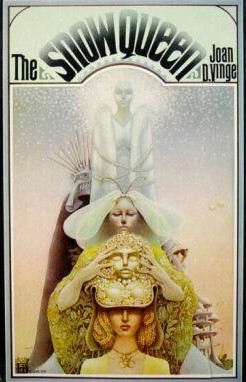
The
Snow Queen, Joan Vinge’s 1981 Hugo-winning novel, is tale of romance and
adventure mostly set on the water world of Tiamat. Tiamat exists in an unusual
solar arrangement: its sun is close to a black hole and is cut off from the
rest of the humanity for 150 years at a time. During that time, the
traditionalists “Summers” rule the planet while the “Winters” rule during the
150 years of contact. It’s an intriguing premise for a science fiction tale
that is mostly entertaining even though it is bogged down with world building
problems and annoying main characters.
The
world-building is generally strong in The Snow Queen despite a couple of
problems. Vinge creates a society on Tiamat that is fairly different from our
own. As mentioned before, Tiamat is divided into two groups of people,
“Summers” and “Winters.” The Summers live simple lives further south while the
Winters are more modernized and prefer city life. Despite the fact that the two
main characters, cousins Moon and Sparks, are Summers, the read does not get
much of a look at Summer society. The majority of the story takes place on
Carbuncle, the planetary capital, during the end of the regime of the Winter
Queen, Arienrhod. Both Summer and Winter society are female-led. Tiamat society
is sexually liberated yet still practices slavery and underground alien
creature fights. I found it an interesting twist that Sparks, the male cousin, was
the one at risk early on in the book of being sold into sex slavery.
Two main problems exist with the
Summer/Winter dynamic. First is more of writing the second is a world building
problem. I don’t know if it because Vinge might have strong anti-modernization
feelings or what but almost every Winter is a terrible person while most of the
Summers are innocent and naïve. This is made clearer as Sparks becomes
Arienrhod’s right hand man. As he becomes a Winter he becomes a more terrible person.
Horrible people as prominent characters are not a bad thing (Arienrhod is an
evil woman and she is the most interesting character in the book) but I would
have liked more of a balance. The problem with the world building is that I
find it hard to believe that Summers could truly take over as cleanly as they
do. Summers destroy all the technology when they come to power and the planet
goes into a mini-dark ages. Winters would fight back considering they lose both
political and economic power. Vinge partially explains this as the rest of
human civilization keeps most technology off Tiamat and what they do export is
flawed so that Tiamatians (Tiamatese?) cannot learn how to build it themselves.
I find it hard to believe more people would not try to break this system (there
are a group of smugglers who trying to do this but their work does not born
much fruit). Outsiders want to keep Tiamat weak so they can control the trade
in Mer’s Blood, a substance only available on Tiamat.
With
the Mer’s Blood, Vinge clearly took a page from Frank Herbert’s Dune. Tiamat is a marginal world (like
Arrakis) but possesses a unique substance that makes the place important.
Mermaid like creatures called Mers live in Tiamat’s oceans and their blood
stops the aging process in humans. The Winters hunt the Mers almost to
extinction while they remain in power. The numbers are allowed to replenish
during the reign of the Summers. It’s a good idea and Vinge’s explanation of
why Mer’s Blood works as it does and the purpose of the Mers is interesting and
well executed.
The
characters in The Snow Queen are a
mixed bag. I found the two main characters, Moon and Sparks, annoying and
childish. Their romance also disturbs me a little because they are first
cousins. They are also quite young for much of the book which does not help.
Sparks reminds me of the clichéd emo characters that exist in many animes and
Japanese video games. It’s not the most flattering comparison. Moon’s behavior
is a bit too erratic and I generally just did not find her interesting.
Arienhrod, the titular Snow Queen, is a much more interesting character. She
does a lot of evil things in the novel but all of them as part of a plan to
free Tiamat from domination by the rest of human civilization. She wants “Winter”
to continue after interstellar travel becomes impossible and for Tiamat to
advance in technology. Her methods and plans are brutal and often heartless but
I could not help myself from rooting for her.
The
book moves along at a brisk pace for the most part and Moon’s trips to other
planets were some of the highlights. I appreciate that Vinge took the time to
give the minor worlds unique cultures. In fact, I would be interested if more
of the book takes place on these other worlds rather than some of the drawn out
ending.
The Snow Queen is a solid though not remarkable
science fiction book. It is a little bit of a letdown after The Foundations of Paradise. I would
still recommend it to other science fiction fans but with a few reservations.
The
next blog will be about Downbelow Station
by C.J. Cherryh. I am excited for this one since it won the year I was born.
Also, it is the second time that I have read one of nominees. The first time
was 1977 when one of the nominees was Frank Herbert’s Children of Dune. As of next blog, I will not only compare the
winner to other Hugo Winners but also to the other nominees if I have already
read them.
